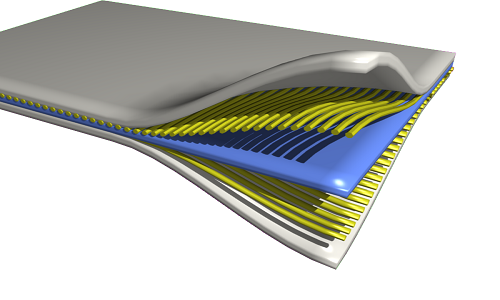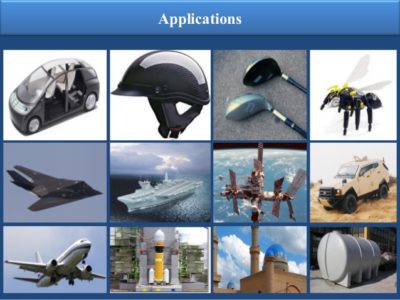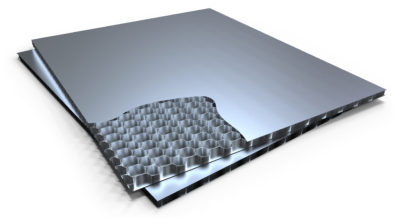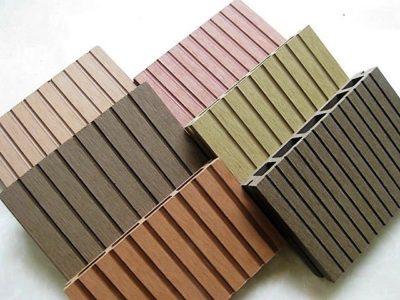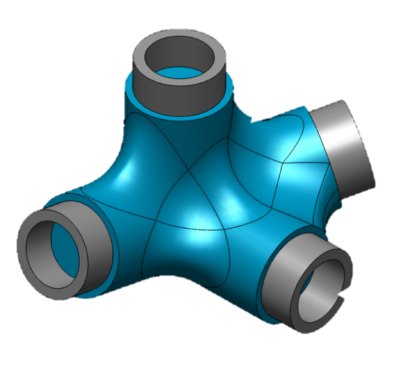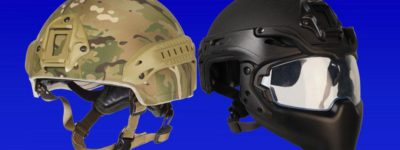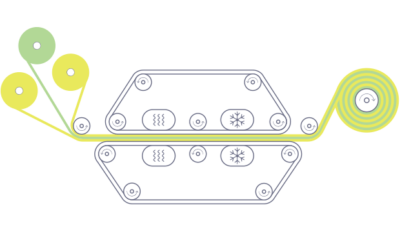An introduction to Composite materials
A Composite material (also called a composition material or shortened to composite, which is the common name) is a material made from two or more constituent materials with significantly different physical or chemical properties that, when combined, produce a material with characteristics different from the individual components.
The individual components remain separate and distinct within the finished structure.
The new material may be preferred for many reasons: common examples include materials which are stronger, lighter, or less expensive when compared to traditional materials.
More recently, researchers have also begun to actively include sensing, actuation, computation and communication into composites, which are known as Robotic Materials.
Typical engineered composite materials include:
- Mortars, concrete
- Reinforced plastics, such as fiber-reinforced polymer
- Metal composites
- Ceramic composites (composite ceramic and metal matrices)
Usage
Composite materials are generally used for buildings, bridges, and structures such as boat hulls, swimming pool panels, race car bodies, shower stalls, bathtubs, storage tanks, imitation granite and cultured marble sinks and countertops. The most advanced examples perform routinely on spacecraft and aircraft in demanding environments.
Types of Composites
Concrete is the most common artificial composite material of all and typically consists of loose stones (aggregate) held with a matrix of cement. Concrete is an inexpensive material, and will not compress or shatter even under quite a large compressive force. However, concrete cannot survive tensile loading (i.e., if stretched it will quickly break apart). Therefore, to give concrete the ability to resist being stretched, steel bars, which can resist high stretching forces, are often added to concrete to form reinforced concrete.
Fibre-reinforced polymers or FRPs include Carbon-fiber-reinforced polymer or CFRP, and Glass-reinforced plastic or GRP.
If classified by matrix then there are thermoplastic composites, short fiber thermoplastics, long fibre thermoplastics or long fibre-reinforced thermoplastics. There are numerous thermoset composites, including paper composite panels. Many advanced thermoset polymer matrix systems usually incorporate aramid fibre and carbon fibre in an epoxy resin matrix.
Shape memory polymer composites are high-performance composites, formulated using fibre or fabric reinforcement and shape
memory polymer resin as the matrix. Since a shape memory polymer resin is used as the matrix, these composites have the ability to be easily manipulated into various configurations when they are heated above their activation temperatures and will exhibit high strength and stiffness at lower temperatures. They can also be reheated and reshaped repeatedly without losing their material properties. These composites are ideal for applications such as lightweight, rigid, deployable structures; rapid manufacturing; and dynamic reinforcement.
High strain composites are another type of high-performance composites that are designed to perform in a high deformation setting and are often used in deployable systems where structural flexing is advantageous. Although high strain composites exhibit many similarities to shape memory polymers, their performance is generally dependent on the fiber layout as opposed to the resin content of the matrix.
A sandwich-structured composite is a special class of composite material that is fabricated by attaching two thin but stiff skins to a lightweight but thick core. The core material is normally low strength material, but its higher thickness provides the sandwich composite with high bending stiffness with overall low density.
Wood plastic composite Wood is a naturally occurring composite comprising cellulose fibres in a lignin and hemicellulose matrix.
Engineered wood includes a wide variety of different products such as wood fibre board, plywood, oriented strand board, wood plastic composite (recycled wood fibre in polyethylene matrix), Pykrete (sawdust in ice matrix), Plastic-impregnated or laminated paper or textiles, Arborite, Formica (plastic) and Micarta. Other engineered laminate composites, such as Mallite, use a central core of end grain balsa wood, bonded to surface skins of light alloy or GRP. These generate low-weight, high rigidity materials.
Advanced Composite Materials (ACMs)
They are also known as advanced polymer matrix composites. These are generally characterized or determined by unusually high strength fibres with unusually high stiffness, or modulus of elasticity characteristics, compared to other materials, while bound together by weaker matrices. These are termed advanced composite materials (ACM) in comparison to the composite materials commonly in use such as reinforced concrete, or even concrete itself. The high strength fibers are also low density while occupying a large fraction of the volume.
Advanced composites exhibit desirable physical and chemical properties that include light weight coupled with high stiffness (elasticity), and strength along the direction of the reinforcing fiber, dimensional stability, temperature and chemical resistance, flex performance, and relatively easy processing. Advanced composites are replacing metal components in many uses, particularly in the aerospace industry.
Composites are classified according to their matrix phase. These classifications are Polymer matrix composites (PMCs), Ceramic
matrix composites (CMCs), and Metal matrix composites (MMCs). Also, materials within these categories are often called “advanced” if they combine the properties of high (axial, longitudinal) strength values and high (axial, longitudinal) stiffness values, with low weight, corrosion resistance, and in some cases special electrical properties.
Advanced composite materials have broad, proven applications, in the aircraft, aerospace, and sports equipment sectors. Even more specifically ACMs are very attractive for aircraft and aerospace structural parts.
ACMs have been developing for NASA’s Advanced Space Transportation Program, armor protection for Army aviation and the Federal Aviation Administration of the USA, and high-temperature shafting for the Comanche helicopter. Additionally, ACMs have a decades long history in military and government aerospace industries. However, much of the technology is new and not presented formally in secondary or undergraduate education, and the technology of advanced composites manufacture is continually evolving.
Thermosets and Thermoplastics- Advanced composite systems are also divided into two basic types, Thermosets and Thermoplastics. Thermosets are by far the predominant type in use today. Thermosets are subdivided into several resin systems including epoxies, phenolics, polyurethanes, and polyimides. Of these, epoxy systems currently dominate the advanced composite industry.
Metal matrix composites (MMC) or ceramic matrix composites (CMC), Composites can also use metal fibres reinforcing other metals, as in metal matrix composites (MMC) or ceramic matrix composites (CMC), which includes bone (hydroxyapatite reinforced with collagen fibres), cermet (ceramic and metal) and concrete. Ceramic matrix composites are built primarily for fracture toughness, not for strength.
Organic matrix/ceramic aggregate composites include asphalt concrete, polymer concrete, mastic asphalt, mastic roller hybrid, dental composite, syntactic foam and mother of pearl. Chobham armour is a special type of composite armour used in military applications.
Additionally, thermoplastic composite materials can be formulated with specific metal powders resulting in materials with a density range from 2 g/cm³ to 11 g/cm³ (same density as lead). The most common name for this type of material is “high gravity compound” (HGC), although “lead replacement” is also used.
These materials can be used in place of traditional materials such as aluminium, stainless steel, brass, bronze, copper, lead, and even tungsten in weighting, balancing (for example, modifying the centre of gravity of a tennis racquet), vibration damping, and radiation shielding applications. High density composites are an economically viable option when certain materials are deemed hazardous and are banned (such as lead) or when secondary operations costs (such as machining, finishing, or coating) are a factor.
Products
Fiber-reinforced composite materials have gained popularity (despite their generally high cost) in high-performance products that need to be lightweight, yet strong enough to take harsh loading conditions such as aerospace components (tails, wings, fuselages, propellers), boat and scull hulls, bicycle frames and racing car bodies. Other uses include fishing rods, storage tanks, swimming pool panels, and baseball bats. The new Boeing 787 structure including the wings and fuselage is composed largely of composites. Composite materials are also becoming more common in the realm of orthopedic surgery.And It is the most common hockey stick material.
Carbon composite is a key material in today’s launch vehicles and heat shields for the re-entry phase of spacecraft. It is widely used in solar panel substrates, antenna reflectors and yokes of spacecraft. It is also used in payload adapters, inter-stage structures and heat shields of launch vehicles. Furthermore, disk brake systems of airplanes and racing cars are using carbon/carbon material, and the composite material with carbon fibers and silicon carbide matrix has been introduced in luxury vehicles and sports cars.
Fiber-reinforced composite pool panel was introduced in 2006, for in-ground swimming pools, residential as well as commercial, as a non-corrosive alternative to galvanized steel.
All-composite military Humvee was introduced in 2007 by TPI Composites Inc and Armor Holdings Inc, the first all-composite military vehicle. By using composites the vehicle is lighter, allowing higher payloads. In 2008, carbon fiber and DuPont Kevlar (five times stronger than steel) were combined with enhanced thermoset resins to make military transit cases by ECS Composites creating 30-percent lighter cases with high strength.
Pipes and fittings for various purpose like transportation of potable water, fire-fighting, irrigation, seawater, desalinated water, chemical and industrial waste, and sewage are now manufactured in glass reinforced plastics.
Design Guidelines for composite materials
To achieve your desired characteristics like good strength, wear resistance, good impact resistance, rigidity, toughness, good weather resistance etc. industry follow these guidelines.
- “Align the fibers with the load’s direction.”
- “Avoid shear loading.”
- “Combine several components into an integral structure.”
- “Use light core material covered with strong composite layer.”
- “Avoid high temperatures.”
- “Involve manufacturing considerations early in the design.”
SUGOI Polymers can provide tailor made solutions for all your Composite Material needs.

